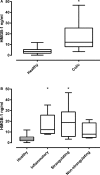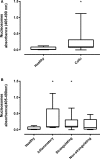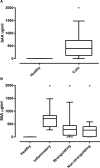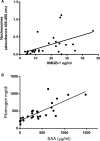Plasma HMGB-1 and Nucleosome Concentrations in Horses with Colic and Healthy Horses
- PMID: 26683003
- PMCID: PMC4913630
- DOI: 10.1111/jvim.13811
Plasma HMGB-1 and Nucleosome Concentrations in Horses with Colic and Healthy Horses
Abstract
Background: Acute gastrointestinal disease occurs commonly in horses. Novel biomarkers might improve the understanding of SIRS and aid diagnosis and determination of prognosis.
Hypotheses: Increased plasma concentrations of the biomarkers HMGB-1 and nucleosomes are associated with severity of gastrointestinal lesions in horses; concentrations of these biomarkers will be greater in horses with lesions more likely to cause SIRS; and will provide additional information compared with standard biomarkers fibrinogen and SAA.
Animals: Thirty horses with gastrointestinal disease, 22 healthy horses.
Methods: Prospective study. Plasma samples taken on admission were used for measurement of HMGB-1, nucleosomes, fibrinogen, and SAA. Values were compared between healthy horses and those with gastrointestinal disease, and between horses with gastrointestinal disease grouped by lesion type (inflammatory, strangulating, and nonstrangulating). Correlations between biomarkers were assessed.
Results: Plasma concentrations of all biomarkers were significantly higher in horses with gastrointestinal disease compared to healthy horses (P ≤ .001). HMGB-1 and nucleosomes were significantly higher in inflammatory and strangulating groups compared to healthy horses (3.5-fold and 5.4-fold increases, respectively, for HMGB-1 (P < .05) and 4.8-fold and 5.6-fold increases for nucleosomes (P < .05)), but concentrations in the group with nonstrangulating disease did not differ from healthy horses. There was significant correlation between HMGB-1 and nucleosomes (Spearman's r = 0.623; P < .001), and fibrinogen and SAA (Spearman's r = 0.801; P < .001) but not between other biomarkers.
Conclusions and clinical importance: High mobility group box-1 and nucleosomes might have use as biomarkers for horses with gastrointestinal disease. Further studies are required to determine kinetics and prognostic value of serial measurements of these biomarkers in horses.
Keywords: HMGB-1; Horse; Nucleosomes; Systemic inflammatory response syndrome.
Copyright © 2015 The Authors. Journal of Veterinary Internal Medicine published by Wiley Periodicals, Inc. on behalf of the American College of Veterinary Internal Medicine.
Figures





References
-
- Epstein KL, Brainard BM, Gomez‐Ibanez SE, et al. Thrombelastography in Horses with Acute Gastrointestinal Disease. J Vet Int Med 2011;25:307–314. - PubMed
-
- Borde L, Amory H, Grulke S, et al. Prognostic value of echocardiographic and Doppler parameters in horses admitted for colic complicated by systemic inflammatory response syndrome. J Vet Emerg Crit Care 2014;24:302–310. - PubMed
-
- Moore JN, Vandenplas ML. Is it the systemic inflammatory response syndrome or endotoxemia in horses with colic? Vet Clin North Am Equine Pract 2014;30:337–351. - PubMed
-
- Roy M‐F. Review article: Sepsis in adults and foals. Vet Clin North Am Equine Pract 2003;20:41–61. - PubMed
-
- Borges AS, Divers TJ, Stokol T, et al. Serum iron and plasma fibrinogen concentrations as indicators of systemic inflammatory diseases in horses. J Vet Int Med 2007;21:489–494. - PubMed
MeSH terms
Substances
LinkOut - more resources
Full Text Sources
Other Literature Sources

